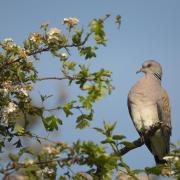Why improving biodiversity and water quality are the key elements of the Countryside Stewardship scheme in Kent
Ever wondered why there is a bare patch in the middle of a field near you? Or why in-field hedges are only cut at certain times of year and grass strips are left next to streams and around the edges of fields planted with arable crops?
It’s all about Countryside Stewardship, a European-funded scheme that offers incentives to landowners and farmers to protect and enhance the natural environment alongside food production. A new window has opened for applications; it closes for Expressions of Intent later this month, so many Kent farmers and landowners will be looking at the environmental management work they are already doing and how they might extend it in the next five years.
Improving biodiversity and water quality are identified as the key elements of the Countryside Stewardship scheme. But it also makes vital contributions to woodland management, protecting historic environment features and maintaining and restoring the natural landscape.
It includes capital grants for environmental works such as new fencing and hedging, coppicing to improve woodland and support for the creation of new woodland areas.
The agricultural landscape in Kent differs from many other counties, with a diverse mix from fruit orchards and arable land to hop vines and lavender fields. While national priorities for Countryside Stewardship are largely similar, specific ones for Kent include protection of saltmarsh and coastal grazing, the maintenance of historic orchards, field margins, ancient woodland and lowland meadows. From the North Downs to the coastal plains in the north of the county, Countryside Stewardship has many options for farmers across Kent.
Water quality is a priority in parts of the High Weald and Medway catchments as is flood-risk management in the Romney Marsh and Rother Valley. Measures which control soil erosion and run off, reduce the impact of nutrients from fertilisers and slow the movement of flood water can all make an important contribution.
While Countryside Stewardship offers an opportunity for farmers and landowners to receive payment for the positive work they are doing to enhance the ecological diversity of their land, the new scheme is not yet completely straightforward.
It was launched last year as a replacement for previous environmental schemes, but the complexity and late availability of information discouraged many potential applicants.
There is no doubt that, particularly for the higher-tier applications, the reporting and evidence requirements are weighty, but with more information readily available this year and clearer timescales for applications, it is to be hoped that the scheme will quickly increase in popularity for the January 2017 start date.
At the heart of Countryside Stewardship are actions to create resting, feeding and nesting opportunities for farmland birds, pollinators and other farm wildlife, so applications with the Wild Pollinator and Farm Wildlife Package are scored higher for providing sources of nectar and pollen, chick food and over winter seed.
In the case of higher-tier applications, these important land-management options will need to be in place on a significant percentage of the farm. This takes us back to what is happening in the fields near you.
Those bare patches are most likely skylark plots, nesting areas for this lovely farmland bird with its uplifting song and which have been in decline. Hedges are left untrimmed at certain times of the year to provide valuable nesting and resting cover for birds, feeding sites for bees and other pollinators. Those grass strips next to fields are providing important wildlife corridors and sources of nectar and pollen and by streams they’re performing the role of reducing and filtering run-off from the fields, to help reduce soil erosion and protect water quality.
w



























